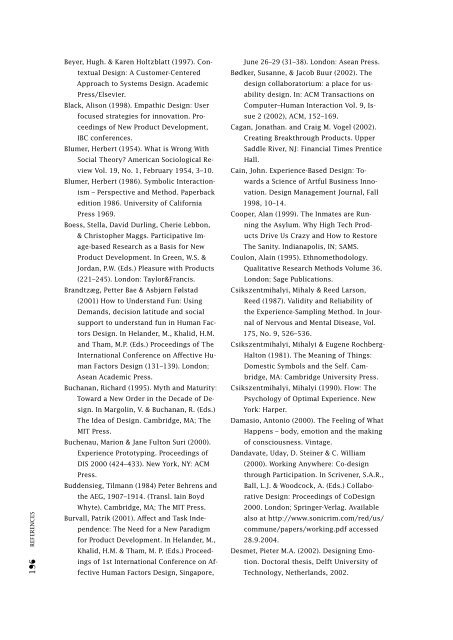Co-experience: Understanding user experiences in social interaction
Co-experience: Understanding user experiences in social interaction
Co-experience: Understanding user experiences in social interaction
You also want an ePaper? Increase the reach of your titles
YUMPU automatically turns print PDFs into web optimized ePapers that Google loves.
196 REFERENCES<br />
Beyer, Hugh. & Karen Holtzblatt (1997). <strong>Co</strong>ntextual<br />
Design: A Customer-Centered<br />
Approach to Systems Design. Academic<br />
Press/Elsevier.<br />
Black, Alison (1998). Empathic Design: User<br />
focused strategies for <strong>in</strong>novation. Proceed<strong>in</strong>gs<br />
of New Product Development,<br />
IBC conferences.<br />
Blumer, Herbert (1954). What is Wrong With<br />
Social Theory? American Sociological Review<br />
Vol. 19, No. 1, February 1954, 3–10.<br />
Blumer, Herbert (1986). Symbolic Interactionism<br />
– Perspective and Method. Paperback<br />
edition 1986. University of California<br />
Press 1969.<br />
Boess, Stella, David Durl<strong>in</strong>g, Cherie Lebbon,<br />
& Christopher Maggs. Participative Image-based<br />
Research as a Basis for New<br />
Product Development. In Green, W.S. &<br />
Jordan, P.W. (Eds.) Pleasure with Products<br />
(221–245). London: Taylor&Francis.<br />
Brandtzæg, Petter Bae & Asbjørn Følstad<br />
(2001) How to Understand Fun: Us<strong>in</strong>g<br />
Demands, decision latitude and <strong>social</strong><br />
support to understand fun <strong>in</strong> Human Factors<br />
Design. In Helander, M., Khalid, H.M.<br />
and Tham, M.P. (Eds.) Proceed<strong>in</strong>gs of The<br />
International <strong>Co</strong>nference on Affective Human<br />
Factors Design (131–139). London;<br />
Asean Academic Press.<br />
Buchanan, Richard (1995). Myth and Maturity:<br />
Toward a New Order <strong>in</strong> the Decade of Design.<br />
In Margol<strong>in</strong>, V. & Buchanan, R. (Eds.)<br />
The Idea of Design. Cambridge, MA; The<br />
MIT Press.<br />
Buchenau, Marion & Jane Fulton Suri (2000).<br />
Experience Prototyp<strong>in</strong>g. Proceed<strong>in</strong>gs of<br />
DIS 2000 (424–433). New York, NY: ACM<br />
Press.<br />
Buddensieg, Tilmann (1984) Peter Behrens and<br />
the AEG, 1907–1914. (Transl. Ia<strong>in</strong> Boyd<br />
Whyte). Cambridge, MA; The MIT Press.<br />
Burvall, Patrik (2001). Affect and Task Independence:<br />
The Need for a New Paradigm<br />
for Product Development. In Helander, M.,<br />
Khalid, H.M. & Tham, M. P. (Eds.) Proceed<strong>in</strong>gs<br />
of 1st International <strong>Co</strong>nference on Affective<br />
Human Factors Design, S<strong>in</strong>gapore,<br />
June 26–29 (31–38). London: Asean Press.<br />
Bødker, Susanne, & Jacob Buur (2002). The<br />
design collaboratorium: a place for usability<br />
design. In: ACM Transactions on<br />
<strong>Co</strong>mputer–Human Interaction Vol. 9, Issue<br />
2 (2002), ACM, 152–169.<br />
Cagan, Jonathan. and Craig M. Vogel (2002).<br />
Creat<strong>in</strong>g Breakthrough Products. Upper<br />
Saddle River, NJ: F<strong>in</strong>ancial Times Prentice<br />
Hall.<br />
Ca<strong>in</strong>, John. Experience-Based Design: Towards<br />
a Science of Artful Bus<strong>in</strong>ess Innovation.<br />
Design Management Journal, Fall<br />
1998, 10–14.<br />
<strong>Co</strong>oper, Alan (1999). The Inmates are Runn<strong>in</strong>g<br />
the Asylum. Why High Tech Products<br />
Drive Us Crazy and How to Restore<br />
The Sanity. Indianapolis, IN; SAMS.<br />
<strong>Co</strong>ulon, Ala<strong>in</strong> (1995). Ethnomethodology.<br />
Qualitative Research Methods Volume 36.<br />
London; Sage Publications.<br />
Csikszentmihalyi, Mihaly & Reed Larson,<br />
Reed (1987). Validity and Reliability of<br />
the Experience-Sampl<strong>in</strong>g Method. In Journal<br />
of Nervous and Mental Disease, Vol.<br />
175, No. 9, 526–536.<br />
Csikszentmihalyi, Mihalyi & Eugene Rochberg-<br />
Halton (1981). The Mean<strong>in</strong>g of Th<strong>in</strong>gs:<br />
Domestic Symbols and the Self. Cambridge,<br />
MA: Cambridge University Press.<br />
Csikszentmihalyi, Mihalyi (1990). Flow: The<br />
Psychology of Optimal Experience. New<br />
York: Harper.<br />
Damasio, Antonio (2000). The Feel<strong>in</strong>g of What<br />
Happens – body, emotion and the mak<strong>in</strong>g<br />
of consciousness. V<strong>in</strong>tage.<br />
Dandavate, Uday, D. Ste<strong>in</strong>er & C. William<br />
(2000). Work<strong>in</strong>g Anywhere: <strong>Co</strong>-design<br />
through Participation. In Scrivener, S.A.R.,<br />
Ball, L.J. & Woodcock, A. (Eds.) <strong>Co</strong>llaborative<br />
Design: Proceed<strong>in</strong>gs of <strong>Co</strong>Design<br />
2000. London; Spr<strong>in</strong>ger-Verlag. Available<br />
also at http://www.sonicrim.com/red/us/<br />
commune/papers/work<strong>in</strong>g.pdf accessed<br />
28.9.2004.<br />
Desmet, Pieter M.A. (2002). Design<strong>in</strong>g Emotion.<br />
Doctoral thesis, Delft University of<br />
Technology, Netherlands, 2002.

















